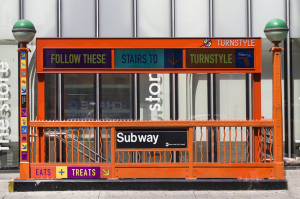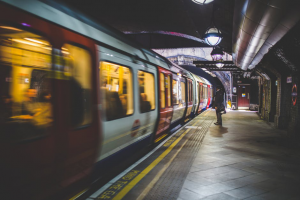
One of the best ways to explore a new city is navigating its diverse neighborhoods on foot—taking in all the sights and sounds as you walk past its historic landmarks and iconic eateries.
When it comes to New York City, however, traveling on foot isn’t just easy on the wallet. Given the city’s growing population, diverse boroughs, and innumerable hot spots, it’s practical as well as crucial to a “complete New York experience”.
Whether you’re visiting the Big Apple during your summer or winter holidays, you don’t want to ruin your trip by being stuck in traffic, losing your reservation at a fancy restaurant or worse still, arriving late to a Broadway show!
Luckily, New York City offers one of the oldest, largest and most reliable public transportation systems in the world, which operates 24/7.
From locals and wide-eyed tourists to celebrities such as Sarah Jessica Parker and Kevin Bacon, literally everyone takes the subway simply because it’s the simplest and quickest way to get from point A to point B.
What You Should Know
Despite its quick and convenient label, however, taking the subway in New York City can be overwhelming for visitors. This is because of the multiple lines and trains that go “Uptown” or “Downtown”, based on different letters and numbers that are ultimately responsible for making your transit even easier.
If you’re not able to make sense of the map, you may have to rely on random strangers to guide you—which isn’t particularly helpful if you don’t speak the language, or end up asking a busy New Yorker who’s running late for a meeting.
If given a fair chance, you will find that NYC’s subway system is one to embrace; not to be intimidated by. Take a deep breath, relax and ensure yourself a safe and stress-free experience by keeping these tips in mind.
Get a MetroCard
First things first, no matter which card you choose, you should know that a paying adult can ride the subway with up to 3 children (max height of 3 ft, 8 in. or 112 cm tall) for free.
As for your MetroCard, you have a choice between “Unlimited”, “Regular Pay-Per-Ride” and “Reduced Fare for Seniors and Disabled People”, all of which can be purchased at vending machines located within each station. You’ll be prompted to provide the amount, the decision for which you should make based on the duration of your stay, and how extensively you’ll be riding the subway. Don’t purchase more than what you intend to use up!
Tip: If you are visiting for 3-7 days and intend make use of the subway frequently (figure greater than 4 fares per person, per day), then a 1-week UNLIMITED MetroCard might be a more economical option than a single ride pass or adding a preset dollar amount onto the card. Note: if you opt to purchase the 1-week UNLIMITED MetroCard, your card will activate with your first use and it will deactivate at the end of the 7-day period, whether or not you use it again.
Bear in mind, not all machines accept cash, so you might want to carry a credit card, just in case. If you’re not well-versed in English, you’ll find a “Select Language” dropdown button located on the LOWEST LEFT SIDE of the website, www.mta.info/nyct, to help you to better understand the subway system, using a language that you are most comfortable with.
Plan Ahead with the MTA TripPlanner
Part of the reason why most tourists struggle with the subway is their lack of itinerary planning. Take advantage of your smartphone and go to the MTA TripPlanner website. After entering your current location and destination, you’ll get 3 different routes to help you decide which train to take.
Pretty easy, right?
Fair warning: Wi-Fi signals may be weak underground, so always keep a subway map handy.
Don’t Be Afraid to Transfer between Trains

You’ll know which lines are transferable based on the black and white bars on the map, which indicate multiple lines at a specific station. Look for numbers and letters listed on the route, and keep an eye out for pedestrian tunnels that are designed specifically to connect two stations. If you should miss your stop, don’t panic. Stay on the train until to reach the next stop from which you can change your travel direction.
Know the Difference between Uptown and Downtown
If you’re in Manhattan, just remember: Uptown = North, Downtown = South. This terminology generally applies while traveling within the borough of Manhattan but it is not used outside of this borough.
If you are planning travel to any of the following outer boroughs (Brooklyn, Queens or the Bronx), look for signage on subway platforms and/or listen to train announcements that announce the general direction of the train. For example, “This is a Brooklyn-bound R local train making all local stops”, “This is a Bronx-bound #2 express train”, etc.
Also know that “streets” run from east to west, while “avenues” run north to south. Some streets, like those appearing south (downtown) from the neighborhood simply known as “The Village”, and all the way down to Manhattan’s southernmost tip (Battery Park) are named, while most in Uptown streets are simply numbered. North of “the Village”, numbered streets increase as you travel further north (uptown) and decrease as you travel south (downtown). Fifth Avenue divides Manhattan’s east and west side regions, so if traveling uptown along the east side, street numbers will be preceded with the letter “E”; if west, “W” (Ex. E34 St, E35 St, W34 St, W35, etc.) The “L” train is the one Manhattan subway line that travels east-to-west, a term that we call “crosstown”. On subway maps, it appears as a gray-colored line.
All this information may seem a bit overwhelming at first, but there really is no reason to get stressed. In a City with over 8 million people, we can assure you that there will always be a helpful someone to assist you in navigating your way around our subways!
Tip: It’s not bad idea to add the “MyTransit NYC Maps” application to your smartphone. This way you will always have a subway map handy. The “MyTransit NYC” is another very useful app to add to your smartphone. This app provides useful information about subway delays and route changes (changes often occur during nights and weekends when track maintenance is conducted).
Local Or Express?
Be aware that the MTA Transit System also runs local and express trains. Local trains make every stop in one direction (Uptown or Downtown). An express train may also run Uptown or Downtown, skipping many stops, normally made by local trains, and thus being the faster option for those in a hurry to be somewhere. As a NYC subway system newbie, you might want to stick to use of local trains that make all stops, just until you get the hang of subway navigation. When traveling, via local or express train lines, always pad your travel time to allow enough time for reaching your destination a little earlier or at least, on time.
More general information for stress-free subway travel
Yellow colored lines: N & Q trains (express) and R &W trains (local) & GENERALLY run almost along Manhattan’s north/south midline before turning east towards the borough of Queens. These lines operate in Brooklyn, Manhattan and Queens.
Blue colored lines: A (express) and C & E (local) run north/south furthest along Manhattan’s west side. These lines also run through the boroughs of Brooklyn and Queens.
Red colored lines: 1 (local) and 2 & 3 (express) trains run north/side along Manhattan’s west side though not as far west as the blue colored train letter described above. These trains operate in Manhattan and the Bronx.
Orange colored lines: B & D (express) and F & M (local) trains. In Manhattan, these lines run slightly east of the yellow colored train routes. These trains operate in the boroughs of Brooklyn, Manhattan & Queens.
Green colored lines: 4 & 5 (express) and 6 (local) trains run along the easternmost side of Manhattan. These trains operate in Manhattan and the Bronx.
Gray colored line: Connects between Manhattan’s east/west sides. Train operates in Manhattan and Brooklyn.
There are a few other train lines and shuttle lines but the ones shown above are the ones that you are most likely to use.
As local New York City tour guides, we highly encourage you to learn more about the subway before planning your trip. With walking tours being one of our most popular tour packages, the subway may be occasionally used as a part of our tour services—and it’s an experience in itself that should not be missed!
For more information, visit the MTA website, and book an exclusive walking tour with friendly Guides who know the City like the back of their hands!

